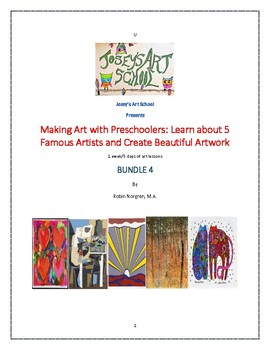BUNDLE 5 Art Lessons Preschool Preschool Artists History PACKET 4 Prek-1ST GRADE
- Zip
Products in this Bundle (5)
Description
Are you looking for a fun and engaging way to introduce your students to some of the most famous artists of the modern era? Look no further than our art lesson bundle featuring Jim Dine, Pablo Picasso, Roy Lichtenstein, Gustav Klimt, and Laurel Burch.
Here are four ways to incorporate this art lesson bundle into your elementary classroom:
- Art History: Use the art of Jim Dine, Pablo Picasso, Roy Lichtenstein, Gustav Klimt, and Laurel Burch to teach your students about different art movements and styles, from pop art to expressionism to art nouveau.
- Drawing and Painting: Each artist in this bundle has their unique style and techniques, making it a great opportunity for your students to explore different mediums and styles. Your students can create their own pieces inspired by the works of these artists.
- Language Arts: Use the works of these artists as a starting point for creative writing exercises. Ask your students to imagine themselves as a character in one of the paintings and write a story from their point of view.
- Math and Geometry: Many of the works of these artists use geometric shapes and patterns, making them perfect for teaching math concepts. Encourage your students to explore the shapes and patterns in each piece and create their own geometric art.
five artists:
Table of Contents
Jim Dine ……………………………………………………………7
Pablo Picasso ……………………………………………………..16
Roy Lichtenstein ………………………………………………….27
Gustav Klimt……………………………………………………….36
Laurel Burch ………………………………………………………..45
WANT THE BUNDLE WITH ALL THIRTY LESSONS? CLICK HERE
Each Artists is highlighted with 3 take away facts geared toward preschoolers/kindergarten students
Art lessons range 20-45 minutes each
IN EACH LESSON:
-Copy of the original painting
-biography of the artist
-questions to ask your students to engage the painting
-FULL COLOR AND THOROUGH step by step instructions
******* Video preview shows the structure of the lesson plan and shows one of the 5 bundles of this curriculum********
CLICK HERE to view my freebies
CLICK HERE to view my DRAWING LESSONS
CLICK HERE to view my ART WITH THE MASTERS ART LESSONS
CLICK HERE to view my CONTEMPORARY ART LESSONS
CLICK HERE to view my ART LESSONS THAT COMPLIMENT POPULAR BOOKS
CLICK HERE to view my SELF ESTEEM PROJECTS
CLICK HERE to view my CLASS MURAL IDEAS
CLICK HERE to view my FUN ART FOLK ART LESSONS
CLICK HERE to view my 3 BUNDLED LESSONS
CLICK HERE to view my 5 BUNDLED LESSONS
Make sure to click the GREEN STAR near my store name so that you can stay in touch with my store. I create new lessons every week.





